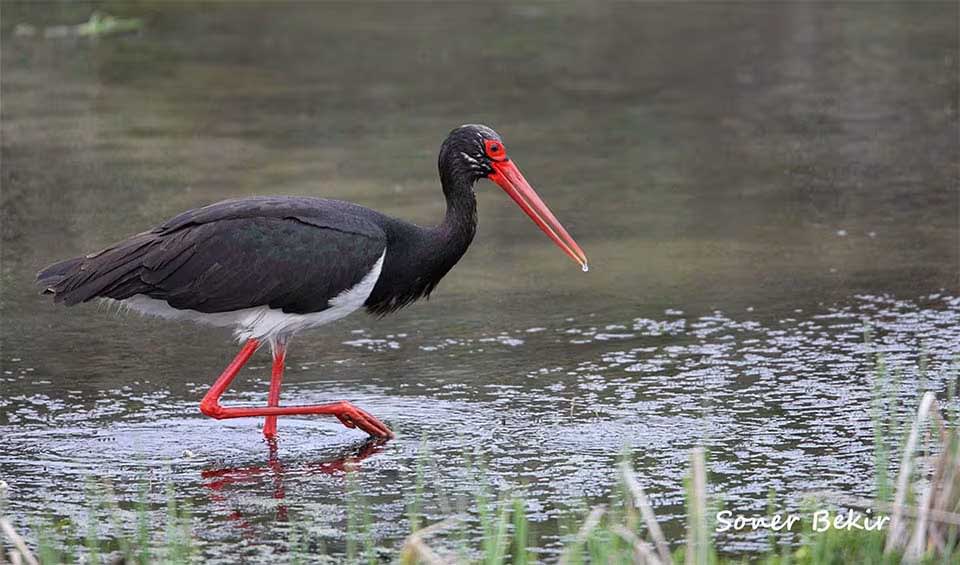A large, elegant bird, part of the stork family, whose beauty is often overshadowed by the more famous White stork. Yet, this species possesses a mystique all its own, with a strikingly contrasting plumage of iridescent black with green, purple, and bronze gloss on its back and wings and stark white underparts. These birds are most often found in the quieter, more secluded stretches of marshes, rivers, and inland waters across Europe, Asia, and Africa.
Unlike their cousins, the Black storks are elusive and less often seen. They favor the tranquility of dense, old forests and secluded woodlands for nesting, often choosing the tallest trees to place their large stick nests. In habitats where trees are sparse, they adapt by nesting on cliffs or rocky outcrops. These nesting sites are typically away from human disturbance, which is notable given the bird’s shy and reclusive nature.
These storks are migratory, covering vast distances between their breeding and wintering grounds. Some populations, however, are sedentary, particularly those in the southernmost parts of their range. During migration, they may form flocks of hundreds, a striking sight against the sky, but outside of these times, they are largely solitary or found in pairs, especially during the breeding season.
Black storks feed on a variety of aquatic creatures. Their diet includes fish, amphibians, small reptiles, insects, and occasionally small mammals and birds, which they hunt with stealth and precision in the waterways of their habitats.
Communication among Black storks involves a series of calls and physical displays. The “chee-lee” call, a high-pitched sound, is often used during mating rituals and to maintain contact between mates and their offspring. Display behaviors include bill-clattering and an “up-down” display where the head and bill are moved rhythmically up and down.
Distribution
 Afghanistan
Afghanistan Albania
Albania Algeria
Algeria Angola
Angola Armenia
Armenia Austria
Austria Azerbaijan
Azerbaijan Belarus
Belarus Belgium
Belgium Benin
Benin Bhutan
Bhutan Bosnia And Herz.
Bosnia And Herz. Botswana
Botswana Bulgaria
Bulgaria Burkina Faso
Burkina Faso Cameroon
Cameroon Central Af. Rep.
Central Af. Rep. Chad
Chad China
China Croatia
Croatia Cyprus
Cyprus Czechia
Czechia Côte D’ivoire
Côte D’ivoire DR Congo (Kinshasa)
DR Congo (Kinshasa) Denmark
Denmark Djibouti
Djibouti Egypt
Egypt Eritrea
Eritrea Estonia
Estonia Eswatini
Eswatini Ethiopia
Ethiopia Finland
Finland France
France Gambia
Gambia Georgia
Georgia Germany
Germany Ghana
Ghana Gibraltar
Gibraltar Greece
Greece Guinea-Bissau
Guinea-Bissau Guinea
Guinea Hong Kong
Hong Kong Hungary
Hungary India
India Iran
Iran Iraq
Iraq Ireland
Ireland Israel
Israel Italy
Italy Japan
Japan Jordan
Jordan Kazakhstan
Kazakhstan Kenya
Kenya Korea
Korea Kuwait
Kuwait Kyrgyzstan
Kyrgyzstan Laos
Laos Latvia
Latvia Lebanon
Lebanon Lesotho
Lesotho Libya
Libya Liechtenstein
Liechtenstein Lithuania
Lithuania Luxembourg
Luxembourg Malawi
Malawi Mali
Mali Malta
Malta Mauritania
Mauritania Moldova
Moldova Mongolia
Mongolia Montenegro
Montenegro Morocco
Morocco Mozambique
Mozambique Myanmar
Myanmar Namibia
Namibia Nepal
Nepal Netherlands
Netherlands Niger
Niger Nigeria
Nigeria North Korea
North Korea North Macedonia
North Macedonia Norway
Norway Oman
Oman Pakistan
Pakistan Poland
Poland Portugal
Portugal Qatar
Qatar Romania
Romania Russia
Russia Rwanda
Rwanda Saudi Arabia
Saudi Arabia Senegal
Senegal Serbia
Serbia Slovakia
Slovakia Slovenia
Slovenia Somalia
Somalia South Africa
South Africa South Sudan
South Sudan Spain
Spain Sri Lanka
Sri Lanka Sudan
Sudan Sweden
Sweden Switzerland
Switzerland Syria
Syria Taiwan
Taiwan Tajikistan
Tajikistan Tanzania
Tanzania Thailand
Thailand Togo
Togo Tunisia
Tunisia Turkey
Turkey Turkmenistan
Turkmenistan UAE
UAE Uganda
Uganda Ukraine
Ukraine United Kingdom
United Kingdom Uzbekistan
Uzbekistan Vietnam
Vietnam Yemen
Yemen Zambia
Zambia Zimbabwe
ZimbabweDid you know?
- Ukraine possesses a significant part of the European Black Stork population, which may be underestimated. No detailed studie have been conducted so far. This is an important location as a territory of breeding range margin, where the European Forest zone borders with steppes.
- This is an indicator species for sustainable forestry.
Anything we've missed?
Help us improve this page by suggesting edits. Glory never dies!
Suggest an editGet to know me
Terrestrial / Aquatic
Altricial / Precocial
Polygamous / Monogamous
Dimorphic (size) / Monomorphic
Active: Diurnal / Nocturnal
Social behavior: Solitary / Pack / Herd
Diet: Carnivore / Herbivore / Omnivore / Piscivorous / Insectivore
Migratory: Yes / No
Domesticated: Yes / No
Dangerous: Yes / No




